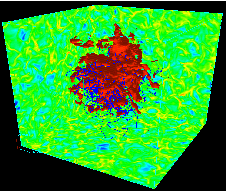
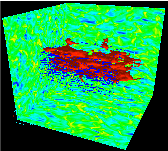
Studies of the emission lines from gas in molecular clouds indicates the presence of supersonic, strongly magnetized turbulence. This turbulence has important implications for star formation in these clouds: it may dominate the spectrum of density fluctuations that ultimately collapse to form stars, and it may alter the balance between pressure and gravity that supports them. However, the properties of supersonic MHD turbulence are not well understood: it is not a regime encountered in many terrestrial flows. Thus, direct numerical simulation of strong MHD turbulence is needed.
This work has been done in collaboration with Charles Gammie (UIUC), and Eve Ostriker (UMd).
Beginning with an initially homogeneous box threaded by a uniform magnetic field, turbulence can be driven by random forcing, and the structure and amplitude of the resulting fluctuations measured. A variety of simulations have been performed using different rates of energy input from the forcing, different magnetic field strengths, and different numerical resolutions.
The images below show the structure of weakly magnetized (left) and strongly magnetized (right) driven turbulence. The logarithm of the density is shown on the faces of the computational volume, the blue lines are representative magnetic field lines, and (to illustrate mixing of the fluid) the red isosurface shows a passive contaminant originally confined to a cylinder at the center of the box. Both models are computed at a resolution of 256^3. Click on either image to download full-sized versions.


The turbulence in the strongly magnetized case is clearly anisotropic, with the magnetic field lines remaining less tangled than the weakly magnetized case. Detailed analysis of simulations with numerical resolutions as high as 512^3 reveals many interesting features, for example the Fourier power spectrum of velocity and magnetic field fluctuations is consistent with a near Kolmogorov power-law distribution in the weak field case, but slightly steeper in the strong field case. At saturation, the decay rate of the turbulence is equal to the energy input by forcing; the decay rate is found to be as large as supersonic hydrodynamical turbulence even with strong magnetic fields: one of our most important results.
More details can be found in the following paper:
``Dissipation in Compressible MHD Turbulence", by J.M. Stone, E.C. Ostriker, & C.F. Gammie, The Astrophysical Journal Letters, 508, L99(1998).Realistic comparisons between the properties of the simulations and observed molecular clouds requires adding the effect of self-gravity. We have studied the decay of saturated turbulence in a self-gravitating gas, and then have compared a wide variety of properties of the simulations (such as the statistics and shapes of dense clumps formed during collapse, and the statistics of the column density and polarization) to actual observations.
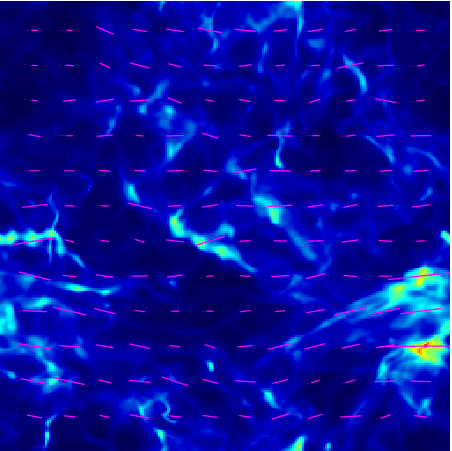 An example of
a synthetic molecular emission map is shown on the left. The colors
are the column density through the 3D computational volume, and the
red lines are the direction and degree of polarization of background
starlight by dust grains that are assumed to be correlated with the
gas density and aligned with the local magnetic field. Using controlled
numerical simulations,
we can explore how properties of molecular clouds that can be measured
by observations change with physical properties of the gas (such as the
magnetic field strength). In turn, this may allow us to use this information
to extract the physical properties of real clouds from current observables.
For example, we find the scatter in polarization angle is sensitive to
the mean magnetic field strength, and can be used as an indirect measure
of this quantity.
An example of
a synthetic molecular emission map is shown on the left. The colors
are the column density through the 3D computational volume, and the
red lines are the direction and degree of polarization of background
starlight by dust grains that are assumed to be correlated with the
gas density and aligned with the local magnetic field. Using controlled
numerical simulations,
we can explore how properties of molecular clouds that can be measured
by observations change with physical properties of the gas (such as the
magnetic field strength). In turn, this may allow us to use this information
to extract the physical properties of real clouds from current observables.
For example, we find the scatter in polarization angle is sensitive to
the mean magnetic field strength, and can be used as an indirect measure
of this quantity.
To get a better idea of how the decay of supersonic MHD turbulence in a self-gravitating gas evolves into the structures observed above, download a movie of the column density in either MPEG format (0.5Mb) or animate gif format (6.1Mb).
Another recent result from our analysis is that the line-of-sight distrubution of clumps in a molecular cloud may be much more complex than implied by line profiles. It is often assumed that discrete clumps along a given line-of-sight will contribute distinct components to emission line profiles because they are likely to be at different radial velocities. However, we find in a turbulent medium that spatially unconnected regions along a given line-of-sight can still give rise to single peaked and smooth velocity profiles, and therefore cannot be easily seperated by velocity information alone. The result is illustrated below, in which optically thin line profiles computed by integrating through one of our simulations are shown at various spatial positions on the left, while the true spatial distrubution of matter along the same lines-of-sight are shown on the right. Note that seemingly smooth profiles in velocity space are actually formed by a highly clumpy medium in position space.
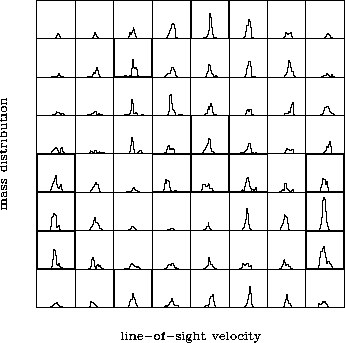
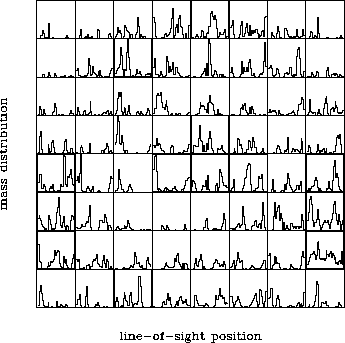
More details can be found in the following papers:
``Kinetic and Structural Evolution of Self-Gravitating, Magnetized Clouds: 2.5-Dimensional Simulations of Decaying Turbulence", by E.C. Ostriker, C.F. Gammie, & J.M. Stone, The Astrophysical Journal, 513, 259 (1999).